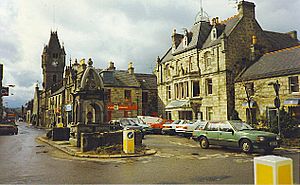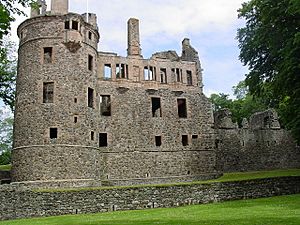Huntly facts for kids
Quick facts for kids Huntly
|
|
|---|---|
 Gordon Square, Huntly |
|
| Population | 4,550 (2020) |
| OS grid reference | NJ5353 |
| Council area | |
| Country | Scotland |
| Sovereign state | United Kingdom |
| Post town | HUNTLY |
| Postcode district | AB54 |
| Dialling code | 01466 |
| Police | Grampian |
| Fire | Grampian |
| Ambulance | Scottish |
| EU Parliament | Scotland |
| UK Parliament |
|
| Scottish Parliament |
|
Huntly (Scottish Gaelic: Srath Bhalgaidh or Hunndaidh) is a town in Aberdeenshire, Scotland. It was once known as Milton of Strathbogie or just Strathbogie. In 2018, about 4,650 people lived there.
Huntly is famous for Huntly Castle. Nearby towns include Keith and Rothiemay. The town and the area around it are named after the Clan Gordon. This powerful family came from the Scottish Borders.
Huntly was the traditional home of the Gordon Highlanders. This army regiment recruited soldiers from across North-East Scotland. The town has two schools: Gordon Primary and The Gordon Schools, which is near Huntly Castle.
Huntly is also home to Dean's bakers. They are well-known for making delicious shortbread biscuits. In 2007, Dean's of Huntly opened a new visitor's centre. You might be interested to know that some owls from the local falconry centre appeared in the Harry Potter movies!
Contents
A Look at Huntly's Past
People have lived near the Bogie and Deveron rivers for a very long time. Evidence of settlements from the Neolithic period has been found. This is a time from thousands of years ago.
An Iron Age hillfort was also found on Battlehill, just outside Huntly. During the first thousand years AD, the area was home to the Picts. They were an ancient people of Scotland. A large Pictish settlement and hillfort were located nearby at Tap o' Noth.
The Castle and the Gordons
The area where Huntly stands was very important. It controlled the routes from Moray to Strathdon and Deeside. The first castle here was a motte-and-bailey castle. It was built around 1180 by Donnchadh II, who was the Earl of Fife.
In 1352, the land was given to the Clan Gordon. They were an Anglo-Norman family from Berwickshire. This happened after David of Strathbogie, a descendant of the original owner, sided with England against Robert I.
The settlement was known as Milton of Strathbogie until 1508. The castle at Strathbogie became very important for the Gordons. They grew powerful through battles and marriages. They became the most important family in North-East Scotland. Their chief was even called the "Cock o' the North."
A busy town grew up around the castle. In 1472, the settlement became a burgh of barony. This meant it had special rights to hold markets. In 1508, the Gordons received a special permission from the king. This allowed them to rename Milton of Strathbogie and the castle to Huntly. This new name came from their original home in Berwickshire.
Challenges and Changes
During the Scottish Reformation, the Gordons were a leading Catholic family. They were involved in conflicts with the new Protestant church. Huntly Castle was attacked in 1562 by Mary, Queen of Scots. It was attacked again in 1594 by James VI.
After the Gordons regained their titles, the town continued to grow. This was during the 17th and 18th centuries. Huntly became a busy market town. It also served the Gordons' palace. Many merchants and artisans worked there.
In 1727, the nearby areas of Dunbennan and Kinnoir became part of Huntly parish. The Duke of Gordon also started to redesign the town. He planned it with straight streets like a grid.
The 18th century saw the growth of the flax industry. People worked from home doing tasks like preparing flax, spinning, bleaching, and weaving. However, poor transport made it hard to send goods to Banff and Aberdeen. Smuggling whisky was also common until it became legal in 1823.
Modern Huntly
In the 19th century, after a decline in the linen trade, Huntly grew again. This was helped by the arrival of rail transport in 1845. Farming also changed from small farms to larger ones. Huntly became an important centre for markets and shipping.
In 1836, the town and the Gordon estates passed to the Duke of Richmond. He was from Sussex. The ownership of much of the land and property stayed with the Dukes of Richmond and Gordon. This was until 1936. At that time, many properties in the town and surrounding farms were sold.
The town's population has changed a little over the 20th century. In 2018, it was about 4,650 people. This is more than the 4,229 people who lived there in 1911. The biggest growth happened in the 19th century. The population went from 1,000 in 1800 to 3,600 in 1861.
Arts and Culture
Huntly is home to Deveron Projects. This is an arts group that invites artists from all over the world. These artists come to live and work in the town. Since 1995, they have used a "town is the venue" idea. This means they connect artists, communities, and places.
Deveron Projects hosts artists and projects that explore many topics. These include forestry, geology, botany, and history. Over 100 famous artists have visited the town.
Walking is often used to bring people together for these projects. Deveron Projects has a Walking Institute. It asks artists to create special walks. Their yearly Slow Marathon started in 2012. It was a collaboration with Ethiopian artist Mihret Kebede. Deveron Projects also runs a community kitchen and gardening projects. In 2013, Huntly won the Creative Place Award because of Deveron Projects. This award celebrates creativity in Scotland's smaller communities.
Geography of Huntly
Brown Hill is a notable hill located within Huntly parish.
Sports and Activities
You can enjoy salmon and trout fishing on the Deveron and Bogie rivers. These are managed by the River Deveron Salmon Fisheries Board. Other fun outdoor activities include golf and Nordic Skiing in Clashindarroch Forest. You can also go walking, mountain biking, and play Rugby.
Huntly has its own sports teams. The local football team is Huntly F.C.. The local rugby union side is Huntly RFC.
Getting Around Huntly
Huntly railway station serves the town. It is managed by ScotRail. The station is on the Aberdeen to Inverness Line. It first opened on September 20, 1854.
Famous People from Huntly
Many interesting people have connections to Huntly:
- Ian Cameron (father of former British Prime Minister, David Cameron) was from Glass, Huntly. He was born at Blairmore House.
- Ronald Center (1913–1973) was a composer. He lived in Huntly from 1943 until he passed away.
- Willie Donald (1953–2022) was a first-class cricketer and former president of Cricket Scotland.
- Iona Fyfe (born 1998) is a talented Scots singer and musician.
- Elizabeth Gordon, Duchess of Gordon (1794–1864) was a Scottish noblewoman and church supporter.
- John Henderson (born 1973) is a professional darts player from Huntly.
- James Legge (1815–1897) was a scholar and missionary to China. He was born in Huntly. He translated many classic Chinese books. He even brought three young Chinese boys to Huntly for school in 1845.
- George MacDonald (1824–1905) was a writer who influenced JRR Tolkien and CS Lewis. Some of his novels describe life in Huntly in the 19th century.
- William Milne (1785–1822) was an early British Protestant missionary to China. He helped start the first Anglo-Chinese school in 1818.
- George Philip (1800–1882) was a mapmaker and founder of a publishing house. He was born in Huntly.
- John Perie (1831–1874) received the Victoria Cross for bravery. He was born in Huntly.
- Jo Pitt (1979–2013) was a para-equestrian from Huntly.
- Andrew Young (born 1992) is a cross-country skier who has achieved success in the World Cup.
- William Mellis Christie (1829–1900) founded the Canadian Mr. Christie brand of cookies and biscuits.
See also
 In Spanish: Huntly para niños
In Spanish: Huntly para niños




